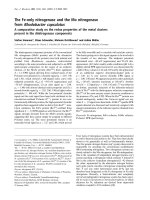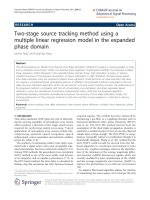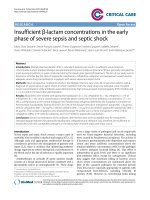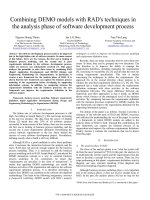Atomic Metal Ion Chemistry in the Gas Phase
Bạn đang xem bản rút gọn của tài liệu. Xem và tải ngay bản đầy đủ của tài liệu tại đây (4 MB, 61 trang )
Atomic Metal Ion Chemistry
in the Gas Phase
Diethard K. Bohme
Ion Chemistry Laboratory
Department of Chemistry
Centre for Research in Mass Spectrometry
Centre for Research in Earth & Space Science
York University, Toronto, Canada
Department of Chemistry
Memorial University
October 2, 2007
Chemical Mass Spectrometry
Create ions (in an ion source).
Look at ions (with a mass spectrometer).
resolve m/z, (dissociate), count
Look at ions react (in a reaction cell).
Ernest Rutherford:
“Ions are jolly little beggars, you can almost see them“
Chemical Mass Spectrometry at York, since 2000 :
2000: Invention of ICP/DRC/MS
(S. Tanner, V. Baranov, then at MDS/SCIEX)
- Dynamic Reaction Cell (DRC) for the chemical
resolution of isobaric interferences in elemental analysis
- requires chemical data base for atomic-ion reactions.
NSERC/NRC/MDS SCIEX/York Partnership.
ICP/SIFT tandem mass spectrometer
2003: Suppression of chemical noise in MS, etc.
(T. Covey, MDS SCIEX)
NSERC/MDS SCIEX/York Partnership
ESI/qQ/SIFT/QqQ multipole ms
OUTLINE
1. ICP/SIFT tandem mass spectrometer
(the universal atomic ion chemical mass spec)
- Periodicities in Reactivities
- The Special Case of Lanthanides
- Atomic Cations as Catalysts
- Influence of Ligation
- Chemical Resolution of Atomic Isobars in
ICP/DRC/MS: a Case Study
2. ESI/qQ/SIFT/QqQ multipole mass spectrometer
(the ultimate chemical mass spectrometer)
- Chemical Reactions of Atomic Metal Dications
- Multiply-Charged Metallated Biological Ions
1.
The Universal Atomic Ion
Chemical Mass Spectrometer
The ICP/SIFT/QqQ instrument
Argon Plasma
P la s m a
S o u rc e
T u rb o
Pum p
H e liu m
I n le t
R eagent
I n le t
B lo w e r
T r ip le Q u a d r u p o le
5500 K
P = 1 atm
D iffu s io n
Pum p
T u rb o
Pum p
T u rb o
Pum p
Aqueous solution
of the atomic salt
is injected via a
nebulizer into
the Ar plasma
__________________________________________________________________________________________________________
An Inductively-Coupled Plasma / Selected-Ion Flow Tube Mass Spectrometer Study of the Chemical
Resolution of Isobaric Interferences. G.K. Koyanagi, V.I. Baranov, S. Tanner and D.K. Bohme, J. Anal. At.
Spectr. 15, 1207-1210 (2000).
Periodic Table of Atomic Salt Solutions
Attractive Features of the ICP Ion Source
intense: ca.1011 ions s-1 in first quad (Ar+ with
0.1% metal ions), ca. 107 ions cm-3 in flow tube
defined: thermal population of electronic states
at ca. 5500 K which relaxes toward 295 K.
rapid: time to change metal ions ca. 30 s
stable: not hours but weeks
versatile: almost universal source of atomic
ions
Reactions of atomic cations: Nb+ with N2O
103
Nb + NbO 2+
+
NbO 2 ·(N 2O)2
NbNO +·(N 2O)2
102
Ion Signal
NbO 2+·(N 2O)3
NbO 2+·N 2O
NbNO +
NbO +
101
Nb+ + N2O NbO+ + N2
NbN+ + NO
Further Oxidation
NbO+ + N2O NbO2+ + N2
NbN+ + N2O NbNO+ + N2
Clustering with N2O
NbO2+ + N2O NbO2(N2O)+
NbO2(N2O)+ +N2O NbO2(N2O)2+
NbO2(N2O)2+ +N2O NbO2(N2O)3+
+
NbNO ·N 2O
NbNO +·(N 2O)3
NbN +
100
Primary Oxidation and Nitration
+
+
NbNO
+
N
O
NbNO(N
O)
2
2
N 2O flow/(10 17 molecules s -1)
NbNO(N2O)+ +N2ONbNO(N2O)2+
________________________________________________________________
NbNO(N2O)2+ +N2ONbNO(N2O)3+
V.V. Lavrov et al., J. Phys. Chem. A 106 (2002) 4581.
0.0
1.0
2.0
3.0
4.0
Surfing the Periodic Table
H
He
59 atomic cations
Li Be
Na M g
K
C
Al Si
Ca Sc
Rb Sr
B
Y
Ti
V
O
F
Ne
P
S
Cl Ar
Cr M n Fe Co Ni Cu Zn Ga Ge As Se Br Kr
Z r N b M o T c R u R h P d A g C d In S n S b T e
C s B a L a H f Ta
Fr Ra Ac
N
W
Re Os
Ir
I
Xe
Pt Au Hg Tl Pb Bi Po At Rn
C e Pr N d Pm Sm Eu G d Tb D y H o Er Tm Yb Lu
Some MO+ oxide ions
15 different molecules
O2, NO, N2O, NO2, CO2, CS2, OCS, D2O,
NH3, CH4, CH3F, CH3Cl, SF6, C6H6, C6F6
1000
5000
2500
Web Data Base
61 atomic cations x 15 molecules = 915 reactions !!
/>
Periodicities in Reactivities
Reactions of atomic cations with O2
1.0
0.8
Reaction branching ratio / Efficiency (k/kc)
0.6
0.4
+
Ca
+
1.0
+
1
0
1 1
s
s
2 1
ds ds
0.8
0.6
0.4
+
Y
0.2
0.0
1.0
4
5
d
0
1
s
+
Zr Nb
2 1
s ds
6 1
d d s ds
(2) (2)
+
2
s
5 1
4
d
8
10
9
d
+
+
d
d
+
+
10 1
0
1
+
+
+
+
As
2
p
d s p
+
+
M+ + O2
3
p
+
Se
p
+
+
Pd Ag Cd In Sn Sb Te
Mo Tc Ru Rh Pd
+
Rb Sr
+
(2) (2) (2) (2)
+
+
+
+
+
+
+
+
+
V Cr Mn Fe Co Ni Cu Zn Ga Ge
Sc Ti
0.2
0.0
+
+
K
(2) (2)
5
d
5 1
7
ds d
8
d
9
d
10
d
10 1
0
1
d s p
p
2
p
3
p
MO+ + O
M+(O2)
0.8
0.6
0.4
0.2
0.0
1.0
+
+
+
+
+
+
+
+
+
+
+
Cs Ba La+ Hf+ (2)+ (2)+ Re Os+ Ir Pt Au Hg Tl Pb Bi Po
(2) (2) (2)
(2) Ta W
0
1
s
2
s
d
1 2
3 1
0.8
0.2
0.0
+
5 1
+
+
6 1
+
Ce Pr
7 1
9
+
+
Nd Pm
10
d
+
Sm Eu
0.6
0.4
4 1
d s d s d s ds d s ds d
+
+
Gd Tb
10 1
0
d s p
1
p
2
p
3
p
+
+
+
Dy Ho Er+ Tm Yb+ Lu
Os+ + 2O2
OsO+ + O3
f1d2 f3s1 f4s1 f5s1 f6s1 f7s1 f7d1s1 f9s1 f10s1 f11s1 f12s1 f13s1 f14s1 f14s2
O-atomtransfer
O2 clustering
Not measured
2nd order O-atomtransfer
No reaction
G.K. Koyanagi et al., J. Phys. Chem. A 106 (2002) 4581.
Reactions of atomic cationswith CO2
1.0
0.8
0.6
+
+
K+ Ca Sc+ Ti
+
+
+
+
+
+
+
+
+
V+ Cr+ Mn+ Fe Co Ni Cu Zn Ga Ge As Se
(4)
0.4
Reactioin branching ratio/Efficiency (k/kc)
0.2
0.0
1.0
2 1
s1 d1s1 d s
0
s
0.4
+
Rb Sr
(2)
0.2
0.0
1.0
+
s0
s1
+
0.4
+
Y
4
s2 d2s1 d
(3)
0.0
s0
s1
9
d
(2) (2)
d10 d10s1 p0
p1
p2
p3
+
(2) (2) (2)
5
d
d5s1 d7
(2) (2)
d8
+
+
+
+
Hf Ta W+ Re Os Ir
+
(3) (2) (2)
+
+
+
+
+
+
+
+
+
+
Zr Nb+ Mo Tc Ru Rh Pd Ag Cd In Sn Sb Te
(2)
+
Cs Ba
0.2
d5 d5s1 d6s1 d8
+
0.8
0.6
(2)
(2)
0.8
0.6
d4
(3) (2) (2)
(2) (3)
La+
d9
(2)
d10 d10s1 p0
+
+
+
Pt Au+ Hg Tl
(3) (2) (2)
6 1
4 1
d2 d1s2 d3s1 d s d5s1 d s d7s1 d9
1
p
2
p
p3
M+ + CO2
MO+ + CO
M+(CO2)
Pb+ Bi+ Po+
(2) (2)
d10 d10s1 p0
p1
2
p
3
p
1.0
0.8
0.6
0.4
0.2
0.0
+
+
+
+
+
+
+
+
Ce+ Pr+ Nd+ Pm+ Sm+ Eu+ Gd Tb Dy Ho Er Tm Yb Lu
(3)
(2)
f1d2 f3s1 f4s1 f5s1 f6s1 f7s1 f7d1s1 f9s1 f10s1 f11s1 f12s1 f13s1 f14s1 f14s2
O-atom transfer
CO2 clustering
Not measured
G.K. Koyanagi, D.K. Bohme, J. Phys.Chem. A 110 (2006) 1232.
Reactions of atomic cations with N2O
1.0
0.8
0.6
0.4
Reactioin branching ratio/Efficiency (k/kc)
0.2
0.0
1.0
(2) (2)
+
+
+
+
+
+
+
Se
Mn+ Fe (3) Ni Cu Zn Ga Ge
+
K Ca Sc Ti V Cr
As
Co+ (3) (2)
(2)
(2)
+
+
+
2 1
s1 d1s1 d s
0
s
+
+
d4
d5 d5s1 d6s1 d8
0.8
0.6
0.4
+
Rb+ Sr
+
s0
(2) (2)
4
s1
9
d
d10 d10s1 p0
p1
2
p
M+ + N2O
3
p
Mo+ Tc+ Ru+ Rh+ Pd+ Ag+ Cd+ In+ Sn+ Sb+ Te+
(2) (2)
Y Zr+ Nb+
0.2
0.0
(2)
+
s2 d2s1 d
5 1
d5 d s d7
(2) (2)
d8
d9 d10 d10s1 p0
p1
p2
p3
MO+ + N2
MN+ + NO
1.0
0.8
0.6
Cs+
+
+
+
+
+
Ba La Hf Ta W Re
0.4
Os+ Ir+ Pt+ Au+ Hg+ Tl+ Pb+ Bi+ Po+
(2) (2) (3) (2) (4)
0.2
0.0
+
0
1
s
s
2
d
(3)
(2) (2)
6 1
1 2 3 1 4 1
9
10
10 1
d s d s d s d5s1 d s d7s1 d d d s p0
p1
p2
1.0
0.8
0.6
0.4
Ce+
Pr+ Nd+ Pm+ Sm+
Eu+
M+(N2O)
p3
(2)
Gd+
+
+
+
+
+
Tb Dy Ho Er Tm Yb
+
+
Lu
0.2
0.0
f1d2 f3s1 f4s1 f5s1 f6s1 f7s1 f7d1s1 f9s1 f10s1 f11s1 f12s1 f13s1 f14s1 f14s2
O-atom transfer
N2O clustering
Not measured
No reaction
N-atom transfer
V.V. Lavrov et al., J. Phys. Chem. A 106 (2002) 4581.
Reaction Branching Ratio/Efficiency (k/kc)
Reactions of atomic cations with SF6
1.0
0.8
0.6
0.4
0.2
0.0
1.0
0.8
0.6
0.4
0.2
0.0
1.0
0.8
0.6
0.4
0.2
0.0
1.0
0.8
0.6
0.4
0.2
0.0
(2)
+
K
0
(3) (4)
+
+ Ti
Ca+ Sc
+
V
1 1 2 1
4
s1 d s d s d
s
(2)
+
Rb
+
Sr+
0
1
s
s
Y
(3)
d9
10
d
10 1
d s
p0
1
p
2
p
3
p
+
4
2
s d2s1 d
(2) (3) (3)
5 1
d5 d s
(4)
d7
8
9
d
d
10
d
10 1
0
p1
d s p
p2
3
p
+
+
+
+
+
+
+
+
+
+
W Re Os Ir Pt Au Hg Tl Pb+ Bi Po
(2) (2)
6 1
s1
Pm Sm
+
Eu
M+ + SF6
MFn+ + SF6-n
M+(SF6)
SFn+ + MF6-n
1
d2 d1s2 d3s1 d4s1 d5s1 d s d7s1 d9 d10 d10s1 p0 p p2 p3
(2) (2)
(2) (2) (2) (2) (2) (2) (2)
(2)
+
+
(2) (2)
Er Tm Yb+
+
+
+
+
Ce+ Pr+ Nd+
f1d2
5 1
d5 d s d6s1 d8
As
Se
+
+
Mo+ Tc+ Ru Rh+ Pd+ Ag Cd+ In+ Sn+ Sb+ Te+
Zr Nb+
+
(3)
(2) (2) (2)
+
+
(4)
Cs Ba+ La+ Hf+ Ta+
s0
+
+
+
+
+
+
+
Cr+ Mn Fe Co Ni Cu Zn Ga Ge+
Gd Tb+ Dy Ho+
+
Lu
n up to 4 !
f3s1 f4s1 f5s1 f6s1 f7s1 f7d1s1 f9s1 f10s1 f11s1 f12s1 f13s1 f14s1 f14s2
MFn+
+
M SF5
SF6 clustering
SFn
No reaction
Not measured
+
C. Ping and D.K. Bohme, J. Phys.Chem. A, in preparation.
OA(O) = 119 kcal mol-1
0
10
-1
k/kc
10
MO2+ M+ + O2 MO+ + O
-2
10
1st Row
2nd Row
3rd Row
Lanthanides
-3
10
-4
10
0
50
100
150
OA (M+) /kcal mol-1
200
0
10
1st Row
2nd Row
3rd Row
Lanthanides
-1
10
k/kc
M+N2O M+ + N2O MO+ + N2
-2
10
100
OA(N2) = 40 kcal mol-1
10-1
10-2
-3
10
10-3
Lanthanides
-4
10
40
0
40
80
120
80
120
160
OA (M+) /kcal mol-1
160
200
10-4
200
240
Kinetic barrier due to electron interaction during bond
redisposition (conventional activation barrier).
10.0
H0 /(kcal mol-1)
TS
+
0.0
-10.0
+
-20.0
3
-30.0
6
-115.0
1
4.0 x 10-13 3.7 x 10-11 >6.4 x 10-10
B3LYP/sdd/6-311+G*
F Rh+
D Fe+
S Y+
Kinetic Barriers Due to Constraints in Electronic Spin
Slow and spin forbiddena
for formation of ground state MO+.
k
rHo
(cm3 s-1) (kcal mol-1)
Cr+ (X6S) + N2O CrO+ (4-) + N2
<1.5x10-13 -46
Mn+ (7S) + N2O MnO+ (5) + N2
<10-13
-28
Co+(3F) + N2O CoO+ (5) + N2
<1.1x10-12 -35
Ni+(2D) + N2O NiO+ (4-) + N2
<6.3x10-13 -33
Mo+ (6S) + N2O MoO+ (4-) + N2 <3.4x10-13 -77
Ru+(4F) + N2O RuO+ (6+) + N2
<3.3x10-13 -48
If overall spin is not conserved, a kinetic barrier is present because
a curve crossing is required to change the spin multiplicity so that
a
The special Case of Lanthanides
Ln•+ + XO [Ln••+ O ]* Ln::O+ + X
X
Two non-f valence electrons are required for the
lanthanide cation to participate in bonding with O.
This can be achieved by the promotion of a 4f electron:
4fn5d06s1 to 4fn-15d16s1.
(For La+, Ce+, and Lu+, the promotion corresponds to d2 d1s1 or s2 d1s1)
Exothermic reactions controlled by
the availability of valence electrons for bonding.
So can expect a correlation between reaction rate
and electron promotion energy PE !
Barriers to Electron Promotion
Ln+ + N2O LnO+ + N2
10-10
20
40
10-11
60
80
10-12
4f n5d06s1 4f n-15d16s1
k/(cm3 molecules-1 s-1)
0
Promotion Energy/(kcal mol-1)
10-9
100
La Ce Pr Nd Pm Sm Eu Gd Tb Dy Ho Er Tm Yb Lu
____________________________________________________
G.K. Koyanagi, D.K. Bohme. J. Phys. Chem. A 105, 8964 (2001)
Arrhenius would be interested!
kexp= kc e-PE/RT
Atomic Ions as Catalysts









